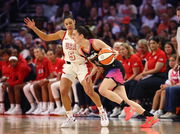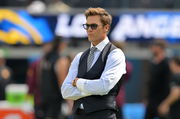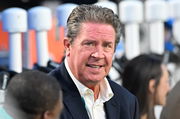
Imago
NCAA, College League, USA Football: Rose Bowl-Ohio State at Oregon Jan 1, 2025 Pasadena, CA, USA Oregon Ducks head coach Dan Lanning speaks in a press conference, PK, Pressekonferenz after the game against the Ohio State Buckeyes in the 2025 Rose Bowl college football quarterfinal game at Rose Bowl Stadium. Pasadena Rose Bowl Stadium CA USA, EDITORIAL USE ONLY PUBLICATIONxINxGERxSUIxAUTxONLY Copyright: xKirbyxLeex 20250101_lbm_al2_370

Imago
NCAA, College League, USA Football: Rose Bowl-Ohio State at Oregon Jan 1, 2025 Pasadena, CA, USA Oregon Ducks head coach Dan Lanning speaks in a press conference, PK, Pressekonferenz after the game against the Ohio State Buckeyes in the 2025 Rose Bowl college football quarterfinal game at Rose Bowl Stadium. Pasadena Rose Bowl Stadium CA USA, EDITORIAL USE ONLY PUBLICATIONxINxGERxSUIxAUTxONLY Copyright: xKirbyxLeex 20250101_lbm_al2_370
Does it ever feel like college sports are stuck in a bygone era as money continues to concentrate at the very top? Dan Lanning’s team alum certainly thinks so. He’s imploring players to recognize their own power and demand a system that truly safeguards their interests. He pulls no punches, doesn’t fault the athletes, and bluntly states that the NCAA’s influence is waning, so someone must champion the players. It’s a bold perspective that’s prompting many to re-evaluate the entire landscape of collegiate athletics.
Watch What’s Trending Now!
The NCAA used to have absolute control over college sports, dictating everything from who could play to which football games would air on TV. But that all changed in 1984, when the association made a major misstep with television rights. Under the leadership of Walter Byers, the NCAA limited broadcasts to one national football game a week, worried that too many televised games would hurt attendance. Schools like Oklahoma and Georgia fought back, claiming this restriction violated federal antitrust law. When the Supreme Court agreed with the schools, control of football TV rights—and the billions of dollars in revenue they brought in—was lost by the NCAA for good.
Now, the four biggest conferences—the SEC, Big Ten, ACC, and Big 12—make more money than the NCAA. The broadcast rights for the CFP alone are reportedly worth $1.3 billion, compared to March Madness’s annual revenue of $1 billion. And Oregon’s alum George Wrighster draws a perfect comparison between the past’s TV rights and the present’s house settlement. “NCAA has lost so many battles. But before we get to blaming the players, like, ‘Oh, players are greedy. They need to change up.’ The coaches have sued the NCAA and won. The schools have sued the NCAA and won. The players have sued the NCAA and won. So what does that tell you? The NCAA is a corrupt organization that is heavy-handed, and now it can’t even; it has no power,” he said.
ADVERTISEMENT
That’s a straight fact. The House v. NCAA settlement has sent shockwaves through college athletics. Athletes Grant House and Sedona Prince challenged the NCAA’s NIL and compensation rules—and achieved a significant result. The agreement compels the NCAA to pay nearly $2.8 billion in back damages over the next decade to college athletes who played from 2016 onward. The result? The schools can now directly compensate athletes, potentially reaching $20.5 million per school in 2025-26.
What an unbelievable gift! More evidence of how Phil and Penny are complete GAMECHANGERS! https://t.co/6L0l5nnYgJ
— Dan Lanning (@CoachDanLanning) August 14, 2025
On that note, there was the famous battle between the NCAA and Diego Pavia, where he was fighting for one year of eligibility as a JUCO transfer and won it. That shows how the NCAA is losing its grip. So, when Wrighster urges players to make their own union, he’s not wrong. “It doesn’t even govern the championship for college football. So the question is, why do we keep trying to pretend that this is the way to go about it? That the NCAA is who needs to be in charge. They don’t. And this is exactly why there needs to be collective bargaining, and there needs to be one individual entity that the players union, the college football players union, negotiates with,” he added.
ADVERTISEMENT
And the foundation of fair rights was rooted long ago. Remember Ed O’Bannon, a former UCLA basketball standout, who challenged the NCAA in a pivotal lawsuit regarding the use of athletes’ NIL? He contended that the NCAA was profiting immensely from players without compensation, a claim the courts ultimately validated as a violation of antitrust laws. In 2014, a federal judge sided with O’Bannon, permitting schools to provide scholarships covering the full cost of attendance, along with a $5,000 annual trust fund for each athlete.
Then the case continued, with the Ninth Circuit upholding the ruling in 2015 and the Supreme Court declining to hear the appeal in 2016, thus solidifying the lower court’s decision. O’Bannon’s battle paved the way for modern NIL rights, revolutionizing college sports by enabling athletes to monetize their NIL for the first time. So, with so many changes coming, making someone new in charge might be the change the sports world is waiting for. But for now, let’s talk about Phil Knight’s generous move for the Ducks.
ADVERTISEMENT
Dan Lanning’s move to thank Phil Knight’s gesture
Well, Phil Knight is making headlines again, but this time it’s cancer, not Nike. The Nike Co-founder and his wife, Penny Knight, have committed an incredible $2 billion to OHSU’s Knight Cancer Institute. OHSU is calling it the largest gift ever given to a U.S. university or academic medical center, exceeding Michael Bloomberg’s $1.8 billion donation to Johns Hopkins. The Knights are looking to revolutionize cancer care by funding research and new treatments and streamlining patient experiences, from nutrition to counseling, aiming to make the institute “the best place on Earth for cancer care,” says director Brian Druker.
Beyond just a financial boost for OHSU, this donation fundamentally restructures the institute. The Knight Cancer Institute will now be a self-governing entity, managed by the Knight Cancer Group and overseen by its own board. This shift addresses previous issues of low morale and distrust in senior leadership, providing staff with clear direction and renewed confidence to innovate in cancer care. Even Dan Lanning couldn’t hold back from thanking both of them for this generous move.
ADVERTISEMENT
As he hits X, saying, “What an unbelievable gift! More evidence of how Phil and Penny are complete GAMECHANGERS!” But the impact extends far beyond OHSU. Steve Stadum, the former interim president, believes the gift elevates both the university and the state, positioning Oregon as a leader in innovative medical research. Current president Shereef Elnahal agrees, describing the donation as “a signal of trust” in OHSU’s clinicians and researchers. Thanks to the Knight’s support, the institute can now truly integrate patient care, improving treatment from diagnosis through recovery, all while advancing research.
Top Stories
Cam Newton Makes NFL Return Conditions Clear to 32 Teams as Panthers Legend Confirms Retirement Stance

Caitlin Clark Shows Concerning Signs vs. Kelsey Plum During USA Camp Debut, per National Reporter

Tom Brady Makes Career Announcement for Vegas as Pete Carroll Addresses Losing Raiders Locker Room

“RIP”: Prayers Pour In as Tom Brady’s Raiders Struck by Tragedy

“NFL Was Crying”: Maxx Crosby Says League Forced Him to Remove Shoes Honoring His Daughter

“Rest in Peace”: Prayers Pour In From Dan Marino as Dolphins Legend Mourns Tragedy in South Florida Football

So, it’s pretty much clear that Oregon doesn’t just focus on changing game dynamics, but also it’s redefining the very future of healthcare.
ADVERTISEMENT
ADVERTISEMENT
ADVERTISEMENT

